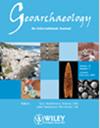新墨西哥州图拉罗萨盆地,Ruppia种子向近岸/陆地环境的深水传递模型及其对晚更新世足迹的年代意义
IF 1.4
3区 地球科学
0 ARCHAEOLOGY
引用次数: 2
摘要
Ruppia本文章由计算机程序翻译,如有差异,请以英文原文为准。
Deep‐water delivery model of Ruppia seeds to a nearshore/terrestrial setting and its chronological implications for Late Pleistocene footprints, Tularosa Basin, New Mexico
Ruppia cirrhosa (Ruppia) seed layers have been used to constrain the age of footprints along the eastern shoreline of Paleolake Otero in southern New Mexico to around 21,000–23,000 calibrated years before the present. However, there remain two unresolved questions that can affect the reliability of the age(s) of the footprints. First, what is the nature of the geological context of the seed layers? Second, did the hard‐water effect impact the accuracy of the radiocarbon dates? It has been argued that the dated Ruppia plants grew in situ in a very shallow, freshwater‐infused system that minimized the hard‐water effect. Many of these Ruppia seed layers contain ball‐like aggregations made of Ruppia plant materials. We provide new evidence that these balls and seed layers were introduced to the discovery site by high wind seiche events during Late Pleistocene thunderstorms. In our proposed site formation model, the Ruppia plants and seeds originated in deeper water settings outside the site, thus it is very likely that the hard‐water effect has impacted the accuracy of the radiocarbon dates. As such, the radiocarbon assays of Ruppia seeds previously used to date the prehistoric footprints along Paleolake Otero could be thousands of years too old.
求助全文
通过发布文献求助,成功后即可免费获取论文全文。
去求助
来源期刊

Geoarchaeology-An International Journal
地学-地球科学综合
CiteScore
3.60
自引率
5.90%
发文量
51
审稿时长
>12 weeks
期刊介绍:
Geoarchaeology is an interdisciplinary journal published six times per year (in January, March, May, July, September and November). It presents the results of original research at the methodological and theoretical interface between archaeology and the geosciences and includes within its scope: interdisciplinary work focusing on understanding archaeological sites, their environmental context, and particularly site formation processes and how the analysis of sedimentary records can enhance our understanding of human activity in Quaternary environments. Manuscripts should examine the interrelationship between archaeology and the various disciplines within Quaternary science and the Earth Sciences more generally, including, for example: geology, geography, geomorphology, pedology, climatology, oceanography, geochemistry, geochronology, and geophysics. We also welcome papers that deal with the biological record of past human activity through the analysis of faunal and botanical remains and palaeoecological reconstructions that shed light on past human-environment interactions. The journal also welcomes manuscripts concerning the examination and geological context of human fossil remains as well as papers that employ analytical techniques to advance understanding of the composition and origin or material culture such as, for example, ceramics, metals, lithics, building stones, plasters, and cements. Such composition and provenance studies should be strongly grounded in their geological context through, for example, the systematic analysis of potential source materials.
 求助内容:
求助内容: 应助结果提醒方式:
应助结果提醒方式:


